OCZ Vertex 4 Review (128GB), Firmware 1.4/1.5 Tested
by Kristian Vättö on August 4, 2012 10:00 AM ESTAnandTech Storage Bench 2011
Last year we introduced our AnandTech Storage Bench, a suite of benchmarks that took traces of real OS/application usage and played them back in a repeatable manner. Anand assembled the traces out of frustration with the majority of what we have today in terms of SSD benchmarks.
Although the AnandTech Storage Bench tests did a good job of characterizing SSD performance, they weren't stressful enough. All of the tests performed less than 10GB of reads/writes and typically involved only 4GB of writes specifically. That's not even enough exceed the spare area on most SSDs. Most canned SSD benchmarks don't even come close to writing a single gigabyte of data, but that doesn't mean that simply writing 4GB is acceptable.
Originally we kept the benchmarks short enough that they wouldn't be a burden to run (~30 minutes) but long enough that they were representative of what a power user might do with their system. Later, however, we created what we refer to as the Mother of All SSD Benchmarks (MOASB). Rather than only writing 4GB of data to the drive, this benchmark writes 106.32GB. This represents the load you'd put on a drive after nearly two weeks of constant usage. And it takes a long time to run.
1) The MOASB, officially called AnandTech Storage Bench 2011—Heavy Workload, mainly focuses on the times when your I/O activity is the highest. There is a lot of downloading and application installing that happens during the course of this test. Our thinking was that it's during application installs, file copies, downloading, and multitasking with all of this that you can really notice performance differences between drives.
2) We tried to cover as many bases as possible with the software incorporated into this test. There's a lot of photo editing in Photoshop, HTML editing in Dreamweaver, web browsing, game playing/level loading (Starcraft II and WoW are both a part of the test), as well as general use stuff (application installing, virus scanning). We included a large amount of email downloading, document creation, and editing as well. To top it all off we even use Visual Studio 2008 to build Chromium during the test.
The test has 2,168,893 read operations and 1,783,447 write operations. The IO breakdown is as follows:
| AnandTech Storage Bench 2011—Heavy Workload IO Breakdown | ||||
| IO Size | % of Total | |||
| 4KB | 28% | |||
| 16KB | 10% | |||
| 32KB | 10% | |||
| 64KB | 4% | |||
Only 42% of all operations are sequential; the rest ranges from pseudo to fully random (with most falling in the pseudo-random category). Average queue depth is 4.625 IOs, with 59% of operations taking place in an IO queue of 1.
Many of you have asked for a better way to really characterize performance. Simply looking at IOPS doesn't really say much. As a result we're going to be presenting Storage Bench 2011 data in a slightly different way. We'll have performance represented as Average MB/s, with higher numbers being better. At the same time we'll be reporting how long the SSD was busy while running this test. These disk busy graphs will show you exactly how much time was shaved off by using a faster drive vs. a slower one during the course of this test. Finally, we will also break out performance into reads, writes, and combined. The reason we do this is to help balance out the fact that this test is unusually write intensive, which can often hide the benefits of a drive with good read performance.
There's also a new light workload for 2011. This is a far more reasonable, typical every day use case benchmark. It has lots of web browsing, photo editing (but with a greater focus on photo consumption), video playback, as well as some application installs and gaming. This test isn't nearly as write intensive as the MOASB but it's still multiple times more write intensive than what we were running last year.
We don't believe that these two benchmarks alone are enough to characterize the performance of a drive, but hopefully along with the rest of our tests they will help provide a better idea. The testbed for Storage Bench 2011 has changed as well. We're now using a Sandy Bridge platform with full 6Gbps support for these tests.
AnandTech Storage Bench 2011—Heavy Workload
We'll start out by looking at average data rate throughout our new heavy workload test:
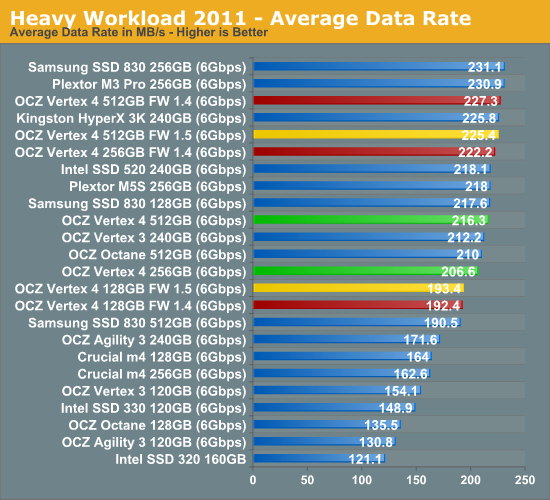
The 1.4 update brought a small boost in our Heavy suite. As you can see in the table above, most IOs are small and the 1.4 and 1.5 firmwares brought marginal improvements to small transfer size performance.
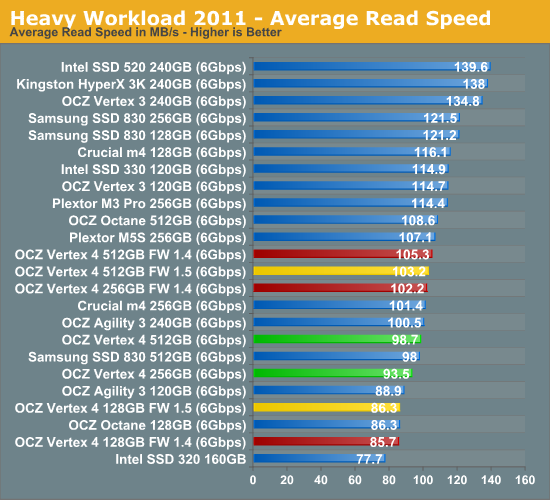
As I mentioned in the previous page, Vertex 4 still lacks read performance at small transfer sizes and the above graphs supports this. The average write performance is very good however and definitely makes up for the middle of the road read performance.
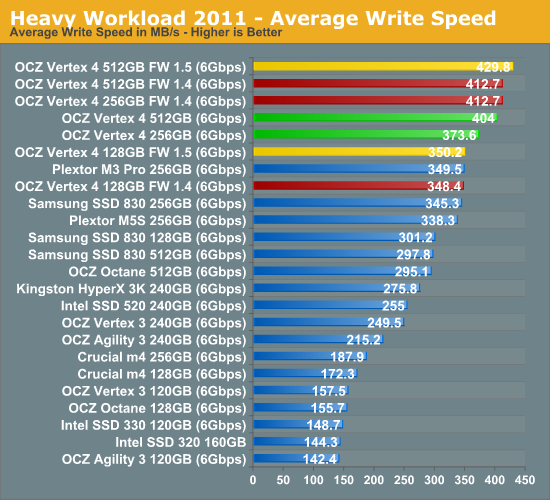
The next three charts just represent the same data, but in a different manner. Instead of looking at average data rate, we're looking at how long the disk was busy for during this entire test. Note that disk busy time excludes any and all idles; this is just how long the SSD was busy doing something:
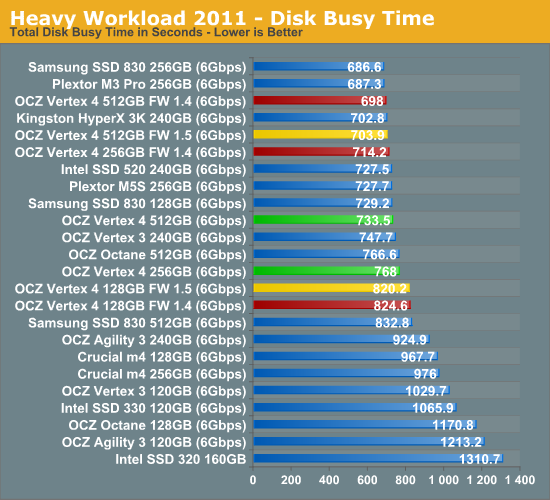
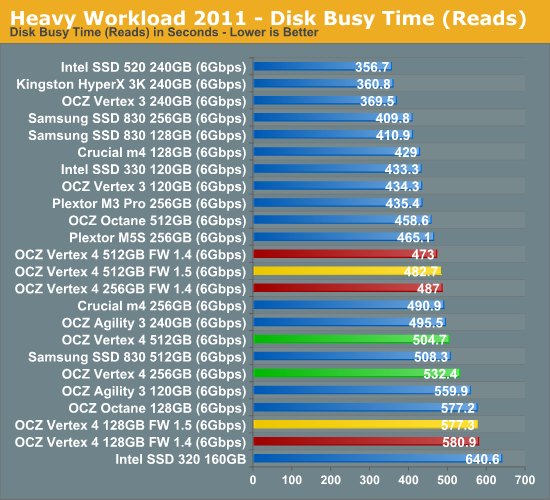
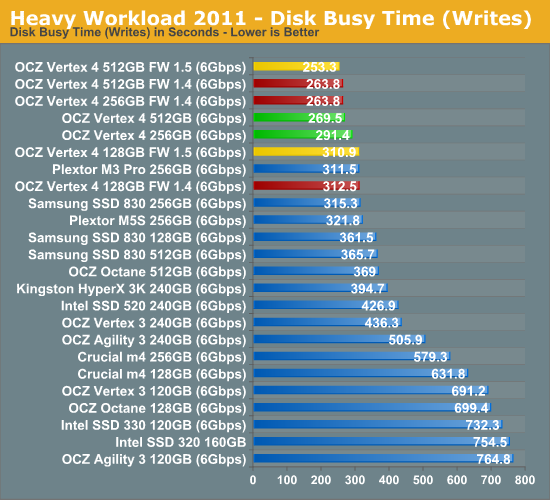










60 Comments
View All Comments
TGressus - Sunday, August 5, 2012 - link
Whatever the cost of doing business will always be passed on to you the consumer.FunBunny2 - Sunday, August 5, 2012 - link
Only by monopolists and oligopolists. Adam Smith was right.Alexvrb - Sunday, August 5, 2012 - link
You're probably confused - weed does that to people. If costs go up, whatever the cause, the cost of the final product goes up too. Doesn't really matter who the company is or what the product is.FunBunny2 - Monday, August 6, 2012 - link
wrong. read up econ 101.B3an - Saturday, August 4, 2012 - link
I'm about to upgrade my Crucial C300 SSD's and wanted to know what people would recommend for my usage... gaming, heavy Photoshop, video editing and 3DS Max work. What would be best for this?I'm guess the Vertex 4 would be one of the best options? But i'm a bit worried about the pretty poor read performance under heavy workload.
What would people recommend?
charleshoskinson - Thursday, August 16, 2012 - link
I'd highly recommend the Samsung 830 or the Crucial M4. I've used both lines of SSDs in my laptops and business computers and never have had a failure. I realize it's anecdotal, but I respect the engineers at Micron and Samsung and like the vertical integration they've built in their product line.charleshoskinson - Thursday, August 16, 2012 - link
Also you may want to consider springing a little money for a sandy bridge E motherboard and 64 GB of RAM. At current prices, you'll pay about 400 for the RAM and you'll be able to mount a software based ramdrive running at speeds around 10-15 times that of a normal SSD. I use my setup to run a linux distro entirely in RAM saving anything I need from my work session encrypted on a dropbox account. I get read speeds around 2.5 GB/s and Write speeds around 2.0 GB/s. On a windows 7 setup you can expect similar speeds.mayankleoboy1 - Saturday, August 4, 2012 - link
the 50% issue affects the drive temporarily only. when it is more than 50% full, it rearranges the data in a few minutes and you get the old speed back. then when you fill it again some more, you get reduced speeds, till the data gets rearrannged.jwilliams4200 - Sunday, August 5, 2012 - link
That seems unlikely. I mean, sure the drive will slow way down while it is doing its reshuffling once it crosses 50%. But after it finishes that housekeeping, it would have to be slower at >50% full than it was at <50% full. Otherwise, why go to the bother of having a "performance mode" and a "storage mode", if both modes are the same speed?Alexvrb - Monday, August 6, 2012 - link
No. Speeds drop DRASTICALLY while it is rearranging, making you briefly wonder if you're using a 5400 RPM HDD from the late 90s. But even after it finishes, speeds are reduced to firmware 1.3 levels. Permanently, unless there is some way to force it to return to performance mode (rearranging things again) after you delete files to bring it back under 50%. It's just silly, modern SSDs should have no need for this sort of nonsense.Anyway, this trick allows them to advertise ever-higher speeds, and even show off reviews of these speeds. I mean who buys an SSD with more than twice the capacity that they need? You're just going to replace it with a newer, better SSD in a couple of years. It's not worth the money. Better off getting a Samsung 830 or an Intel 520 that's the right size.